Matplotlib绘图设置--- 图例设置
plt.legend()和ax.legend()参数设置
自动会将每条线的标签与其风格、颜色进行匹配。
plt.legend(*args, **kwargs)
Place a legend on the axes.
Call signatures::
legend()
legend(labels)
legend(handles, labels)
The call signatures correspond to three different ways how to use
this method.
**1. Automatic detection of elements to be shown in the legend**
The elements to be added to the legend are automatically determined,
when you do not pass in any extra arguments.
In this case, the labels are taken from the artist. You can specify
them either at artist creation or by calling the
:meth:`~.Artist.set_label` method on the artist::
line, = ax.plot([1, 2, 3], label='Inline label')
ax.legend()
or::
line, = ax.plot([1, 2, 3])
line.set_label('Label via method')
ax.legend()
Specific lines can be excluded from the automatic legend element
selection by defining a label starting with an underscore.
This is default for all artists, so calling `Axes.legend` without
any arguments and without setting the labels manually will result in
no legend being drawn.
**2. Labeling existing plot elements**
To make a legend for lines which already exist on the axes
(via plot for instance), simply call this function with an iterable
of strings, one for each legend item. For example::
ax.plot([1, 2, 3])
ax.legend(['A simple line'])
Note: This way of using is discouraged, because the relation between
plot elements and labels is only implicit by their order and can
easily be mixed up.
**3. Explicitly defining the elements in the legend**
For full control of which artists have a legend entry, it is possible
to pass an iterable of legend artists followed by an iterable of
legend labels respectively::
legend((line1, line2, line3), ('label1', 'label2', 'label3'))
Parameters
----------
handles : sequence of `.Artist`, optional
A list of Artists (lines, patches) to be added to the legend.
Use this together with *labels*, if you need full control on what
is shown in the legend and the automatic mechanism described above
is not sufficient.
The length of handles and labels should be the same in this
case. If they are not, they are truncated to the smaller length.
labels : sequence of strings, optional
A list of labels to show next to the artists.
Use this together with *handles*, if you need full control on what
is shown in the legend and the automatic mechanism described above
is not sufficient.
Other Parameters
----------------
loc : str or pair of floats, default: :rc:`legend.loc` ('best' for axes, 'upper right' for figures)
The location of the legend.
The strings
``'upper left', 'upper right', 'lower left', 'lower right'``
place the legend at the corresponding corner of the axes/figure.
The strings
``'upper center', 'lower center', 'center left', 'center right'``
place the legend at the center of the corresponding edge of the
axes/figure.
The string ``'center'`` places the legend at the center of the axes/figure.
The string ``'best'`` places the legend at the location, among the nine
locations defined so far, with the minimum overlap with other drawn
artists. This option can be quite slow for plots with large amounts of
data; your plotting speed may benefit from providing a specific location.
The location can also be a 2-tuple giving the coordinates of the lower-left
corner of the legend in axes coordinates (in which case *bbox_to_anchor*
will be ignored).
For back-compatibility, ``'center right'`` (but no other location) can also
be spelled ``'right'``, and each "string" locations can also be given as a
numeric value:
=============== =============
Location String Location Code
=============== =============
'best' 0
'upper right' 1
'upper left' 2
'lower left' 3
'lower right' 4
'right' 5
'center left' 6
'center right' 7
'lower center' 8
'upper center' 9
'center' 10
=============== =============
bbox_to_anchor : `.BboxBase`, 2-tuple, or 4-tuple of floats
Box that is used to position the legend in conjunction with *loc*.
Defaults to `axes.bbox` (if called as a method to `.Axes.legend`) or
`figure.bbox` (if `.Figure.legend`). This argument allows arbitrary
placement of the legend.
Bbox coordinates are interpreted in the coordinate system given by
`bbox_transform`, with the default transform
Axes or Figure coordinates, depending on which ``legend`` is called.
If a 4-tuple or `.BboxBase` is given, then it specifies the bbox
``(x, y, width, height)`` that the legend is placed in.
To put the legend in the best location in the bottom right
quadrant of the axes (or figure)::
loc='best', bbox_to_anchor=(0.5, 0., 0.5, 0.5)
A 2-tuple ``(x, y)`` places the corner of the legend specified by *loc* at
x, y. For example, to put the legend's upper right-hand corner in the
center of the axes (or figure) the following keywords can be used::
loc='upper right', bbox_to_anchor=(0.5, 0.5)
ncol : integer
The number of columns that the legend has. Default is 1.
prop : None or :class:`matplotlib.font_manager.FontProperties` or dict
The font properties of the legend. If None (default), the current
:data:`matplotlib.rcParams` will be used.
fontsize : int or float or {'xx-small', 'x-small', 'small', 'medium', 'large', 'x-large', 'xx-large'}
Controls the font size of the legend. If the value is numeric the
size will be the absolute font size in points. String values are
relative to the current default font size. This argument is only
used if `prop` is not specified.
numpoints : None or int
The number of marker points in the legend when creating a legend
entry for a `.Line2D` (line).
Default is ``None``, which will take the value from
:rc:`legend.numpoints`.
scatterpoints : None or int
The number of marker points in the legend when creating
a legend entry for a `.PathCollection` (scatter plot).
Default is ``None``, which will take the value from
:rc:`legend.scatterpoints`.
scatteryoffsets : iterable of floats
The vertical offset (relative to the font size) for the markers
created for a scatter plot legend entry. 0.0 is at the base the
legend text, and 1.0 is at the top. To draw all markers at the
same height, set to ``[0.5]``. Default is ``[0.375, 0.5, 0.3125]``.
markerscale : None or int or float
The relative size of legend markers compared with the originally
drawn ones.
Default is ``None``, which will take the value from
:rc:`legend.markerscale`.
markerfirst : bool
If *True*, legend marker is placed to the left of the legend label.
If *False*, legend marker is placed to the right of the legend
label.
Default is *True*.
frameon : None or bool
Control whether the legend should be drawn on a patch
(frame).
Default is ``None``, which will take the value from
:rc:`legend.frameon`.
fancybox : None or bool
Control whether round edges should be enabled around the
:class:`~matplotlib.patches.FancyBboxPatch` which makes up the
legend's background.
Default is ``None``, which will take the value from
:rc:`legend.fancybox`.
shadow : None or bool
Control whether to draw a shadow behind the legend.
Default is ``None``, which will take the value from
:rc:`legend.shadow`.
framealpha : None or float
Control the alpha transparency of the legend's background.
Default is ``None``, which will take the value from
:rc:`legend.framealpha`. If shadow is activated and
*framealpha* is ``None``, the default value is ignored.
facecolor : None or "inherit" or a color spec
Control the legend's background color.
Default is ``None``, which will take the value from
:rc:`legend.facecolor`. If ``"inherit"``, it will take
:rc:`axes.facecolor`.
edgecolor : None or "inherit" or a color spec
Control the legend's background patch edge color.
Default is ``None``, which will take the value from
:rc:`legend.edgecolor` If ``"inherit"``, it will take
:rc:`axes.edgecolor`.
mode : {"expand", None}
If `mode` is set to ``"expand"`` the legend will be horizontally
expanded to fill the axes area (or `bbox_to_anchor` if defines
the legend's size).
bbox_transform : None or :class:`matplotlib.transforms.Transform`
The transform for the bounding box (`bbox_to_anchor`). For a value
of ``None`` (default) the Axes'
:data:`~matplotlib.axes.Axes.transAxes` transform will be used.
title : str or None
The legend's title. Default is no title (``None``).
title_fontsize: str or None
The fontsize of the legend's title. Default is the default fontsize.
borderpad : float or None
The fractional whitespace inside the legend border.
Measured in font-size units.
Default is ``None``, which will take the value from
:rc:`legend.borderpad`.
labelspacing : float or None
The vertical space between the legend entries.
Measured in font-size units.
Default is ``None``, which will take the value from
:rc:`legend.labelspacing`.
handlelength : float or None
The length of the legend handles.
Measured in font-size units.
Default is ``None``, which will take the value from
:rc:`legend.handlelength`.
handletextpad : float or None
The pad between the legend handle and text.
Measured in font-size units.
Default is ``None``, which will take the value from
:rc:`legend.handletextpad`.
borderaxespad : float or None
The pad between the axes and legend border.
Measured in font-size units.
Default is ``None``, which will take the value from
:rc:`legend.borderaxespad`.
columnspacing : float or None
The spacing between columns.
Measured in font-size units.
Default is ``None``, which will take the value from
:rc:`legend.columnspacing`.
handler_map : dict or None
The custom dictionary mapping instances or types to a legend
handler. This `handler_map` updates the default handler map
found at :func:`matplotlib.legend.Legend.get_legend_handler_map`.
Returns
-------
:class:`matplotlib.legend.Legend` instance
#label参数设置简易图例
plt.plot(x, np.sin(x), '-g', label='sin(x)')
plt.plot(x, np.cos(x), ':b', label='cos(x)')
plt.axis('equal')
#显示和设置图例
plt.legend()
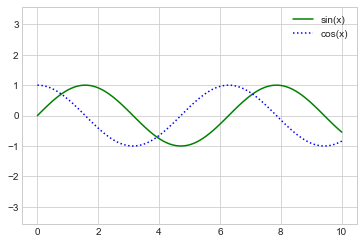
#设置绘图风格
plt.style.use('classic')
fig, ax = plt.subplots()
ax.plot(x, np.sin(x), '-b', label='Sine')
ax.plot(x, np.cos(x), '--r', label='Cosine')
ax.axis('equal')
leg = ax.legend()

#loc设置图例位置,frameon设置边框
ax.legend(loc='upper left', frameon=False)
fig
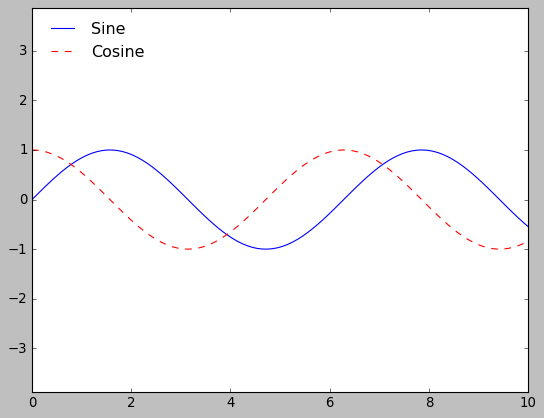
#ncol设置图例标签列数
ax.legend(frameon=False, loc='lower center', ncol=2)
fig

#fancybox设置圆角边框,shadow增加阴影,framealpha改变外框透明度,borderpad设置文字间距
ax.legend(fancybox=True, framealpha=1, shadow=True, borderpad=1)
fig
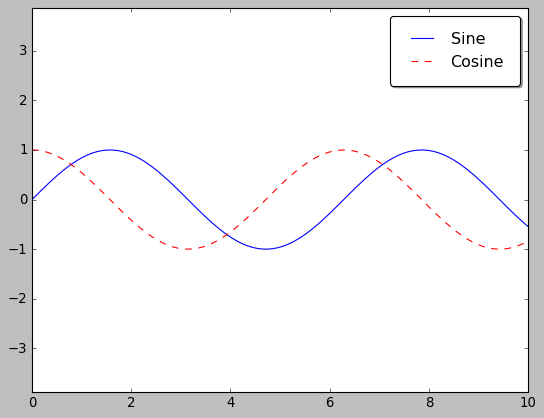
选择图例显示元素
#np.newaxis设置排序的方向
#y是通过广播功能得到一个4 * len(x)维数的数组
y = x[:, np.newaxis] + np.pi * np.arange(0, 2, 0.5)
#方法一:统一绘制
#lines变量时一组plt.Line2D实例
lines = plt.plot(x, y)
#选取其中的图形进行设置标签
plt.legend(lines[:2], ['first','second'], loc='best')
#方法二:分别绘制
plt.plot(x, y[:,0], label='first')
plt.plot(x, y[:,1], label='second')
plt.plot(x, y[:,2:])
plt.legend(framealpha=1, frameon=True, loc='best')
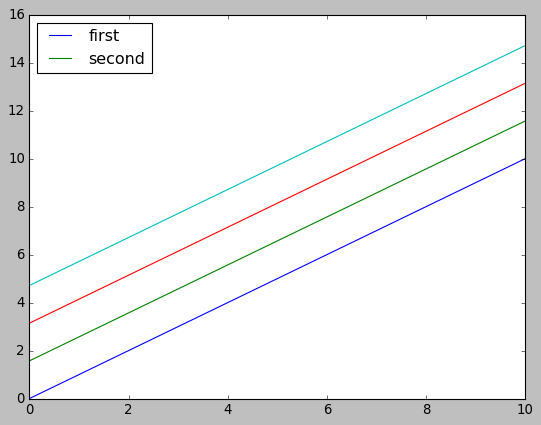
同时显示多图例
在Matplotlib中一般标准legend接口只能为一张图创建一个图例,如果用plt.legend()或ax.legend()创建第二图例时,第一图例会被覆盖。但是,可通过从头开始创建一个新的图例艺术家对象(legend artist),然后用底层的(lower-level)ax.add_artist()方法在图上添加第二个图例。
fig, ax = plt.subplots()
lines = []
styles = ['-','--','-.',':']
colors = ['b','k','g','r']
x = np.linspace(0, 10, 1000)
for i in range(len(styles)):
lines += ax.plot(x, np.sin(x-i * np.pi/2),
styles[i], color=colors[i])
ax.axis('equal')
#设置第一个图例要显示的元素和标签
ax.legend(lines[:2], ['LineA','LineB'],
loc='upper right', frameon=False)
#根据一个Legend对象用add_artist方法添加第二个图例要显示的元素和标签
from matplotlib.legend import Legend
leg = Legend(ax, lines[2:], ['lineC','lineD'],
loc='lower right', frameon=False)
ax.add_artist(leg);
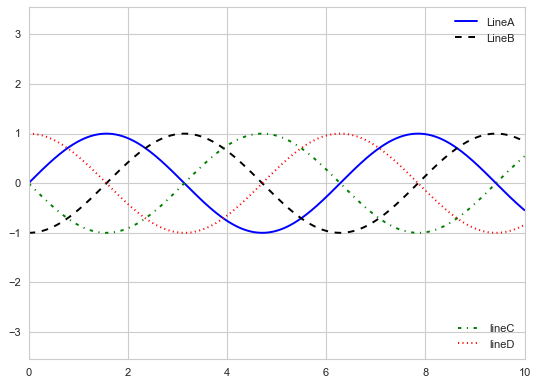
Matplotlib绘图设置--- 图例设置的更多相关文章
- matplotlib绘图教程,设置标签与图例
大家好,欢迎大家阅读周四数据处理专题,我们继续介绍matplotlib作图工具. 在上一篇文章当中我们介绍了matplotlib这个包当中颜色.标记和线条这三种画图的设置,今天我们同样也介绍三种新的设 ...
- Matplotlib绘图双纵坐标轴设置及控制设置时间格式
双y轴坐标轴图 今天利用matplotlib绘图,想要完成一个双坐标格式的图. fig=plt.figure(figsize=(20,15)) ax1=fig.add_subplot(111) ax1 ...
- 【原】在Matplotlib绘图过程中设置X轴的刻度和显示文本
使用Matplotlib进行绘图时,当x轴的数据太多的时候,就需要设置x轴的刻度和显示文本,关键代码如下: 绘图结果如下:
- Python用matplotlib绘图网格线的设置
一.X轴网格线的设置 import matplotlib.pyplot as plt import numpy as np from pylab import mpl mpl.rcParams['fo ...
- Python matplotlib绘图设置图例
一.语法简介 plt.legend(loc=2,edgecolor='red',facecolor='green',shadow='True',fontsize=10) #edgecolor 图例边框 ...
- 4.11Python数据处理篇之Matplotlib系列(十一)---图例,网格,背景的设置
目录 目录 前言 (一)图例legend 1.默认不带参数的图例 2.添加参数的图例 3.将图例移动到框外 (二)网格grid 1.说明 2.源代码: 3.输出效果 (三)背景axses 1.设置全局 ...
- (数据科学学习手札100)搞定matplotlib中的字体设置
本文示例文件已上传至我的Github仓库https://github.com/CNFeffery/DataScienceStudyNotes 1 简介 matplotlib作为数据可视化的利器,被广泛 ...
- python matplotlib 中文显示参数设置
python matplotlib 中文显示参数设置 方法一:每次编写代码时进行参数设置 #coding:utf-8import matplotlib.pyplot as pltplt.rcParam ...
- echarts仪表盘如何设置图例(legend)
echarts 图表中经常需要对不同的颜色设置图例标识不同的意义,而仪表盘的指针只存在一个值,如何表示不同颜色的意义,官网配置项并未给出该功能: 不同段的颜色是通过axisLine->lineS ...
- python matplotlib 中文显示乱码设置
python matplotlib 中文显示乱码设置 原因:是matplotlib库中没有中文字体.1 解决方案:1.进入C:\Anaconda64\Lib\site-packages\matplot ...
随机推荐
- VMware虚拟机Ubuntu系统如何占满整个屏幕
VMware虚拟机Ubuntu系统分辨率调节 桌面右击--Disoplay Settings 选择一个跟本机系统一样或者相近的.(本机小米笔记本win11,具体看自己的情况) 结束.
- 【Azure 应用服务】Azure Function 部署槽交换时,一不小心把预生产槽上的配置参数交换到生产槽上,引发生产错误
问题描述 部署Function代码先到预生产槽中,进行测试后通过交换方式,把预生产槽中的代码交换到生产槽上,因为在预生产槽中的设置参数值与生产槽有不同,但是在交换的时候,没有仔细检查.导致在交换的时候 ...
- rpa使用自带数据抓取方式抓取页面元素
大家好,我是一方. 今天我们一起看一下如何使用rpa自带的功能来抓取自己想要的页面元素,这里我们以抖音为例来抓取某个领域的作者列表. 想要获取页面元素,大概的流程为:确定页面元素.分析页面元素.使用自 ...
- Zabbix_get基础命令浅析
zabbix_get是Zabbix监控系统的一个命令行工具,可以用于从Zabbix服务器或代理获取数据.以下是zabbix_get的基本使用方法: 1.获取一个单独的键值对 使用以下命令可以获取一个单 ...
- 新博客 VuejsDev.com 用于梳理知识点
新博客 VuejsDev.com 用于梳理知识点 https://www.vuejsdev.com/ 后期没有精力发布了,迁移到博客园了,防止服务器到期~ [VueJsDev] 目录列表 https: ...
- Editor - Goto Location: Multiple Definitions - vscode 多个定义,直接跳转到主定义 不进行选择
Editor - Goto Location: Multiple Definitions - vscode 多个定义,直接跳转到主定义 不进行选择 配置里面 搜 多
- Vue3 好文收藏
实用!最新的几个 Vue 3 重要特性提案 http://www.zyiz.net/tech/detail-142574.html
- 前后端分离Ajax入门
前后端分离之Ajax入门 一.概念 Ajax(Asynchronous Javascript And XML),即是异步的JavaScript和XML,Ajax其实就是浏览器与服务器之间的一种异步通信 ...
- 【C语言复习笔记】一些要点
[C语言复习笔记]一些要点 按学校教材复习的,整理的是我不熟悉的地方 最近C用的好少,快忘完了就赶紧整理一下(Python真好玩) 第一章 初识C语言 存储器 内存容量的大小,取决于地址总线的数量 \ ...
- TP6框架--EasyAdmin学习笔记:实现数据库增删查改
这是我写的学习EasyAdmin的第三章,这一章我给大家分享下如何进行数据库的增删查改 上一章链接:点击这里前往 上一章我们说到,我仿照官方案例,定义了一条路由goodsone和创建了对应数据库,我们 ...
